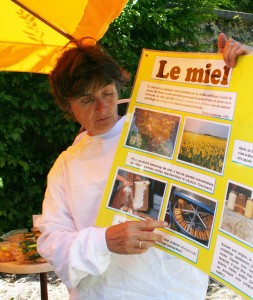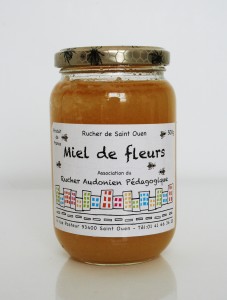After our visit to the bee colony, we returned to the area around the beekeepers’ office to hear Madame Bonnet talk about honey.
In the photo above, Madame Bonnet is explaining how honey is extracted from the honeycombs. First the wax caps are cut off the comb to expose the honey (photo to the left of her hand). Then the combs are placed in a centrifuge (photo to which she is pointing). After the honey is extracted, the wax combs can be recuperated.
In general, bees forage within a radius of about 3 km from their hive. The bees from the Saint-Ouen apiary find the following flowers within their foraging range:
dahlia
cosmos
daisy
clover
lime
chestnut
wild rose
blackberry
rose
raspberry
gooseberry
squash
and other flowers…
When they land on a flower, bees use their proboscis to suck up the nectar. They carry it back to the hive and transfer it to other bees. This second group of bees deposits the nectar into the cells of the honeycomb. While the nectar is in their stomachs, proteins and enzymes convert it to honey. After the honey has been deposited in the cells, the bees fan it to evaporate the water, then cap the cells with wax. In short, the honey that we eat is flower nectar that honey bees have collected, regurgitated, and dehydrated.
I purchased a 500-gram jar of honey and took it back to our apartment to taste. It is quite fragrant and has a mild, distinctive flavor. Spread on toasted country bread or stirred into yoghurt, it adds a delicious, sweet dimension to our breakfast.
Special thanks go out to the Saint-Ouen tourist office for researching the names of the flowers in the vicinity of the apiary.
We participate in Wanderfood Wednesdays. Head over there to explore food from around the world!
Like our blog? Join us on Facebook!
Tags: beekeeping, honey, Rucher Audonien Pédagogique, Saint-Ouen



